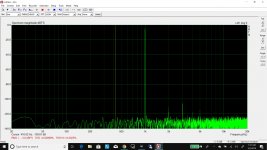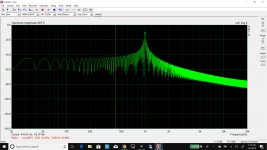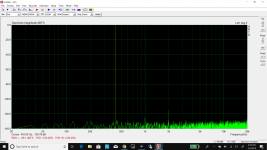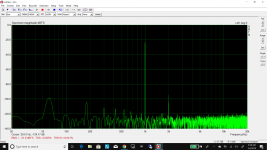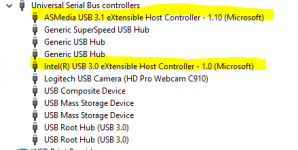What i have done and would suggest is using the HP 8903 as your front end. the internal levels can be routed to a soundcard with little effort and you get the best of both. An analog front end with some great capabilities and protection with the soundcard and software for analysis. Jan's autoranger is quite nice but the additional capabilities (bandpass filters, notch filter etc.) of the 8903 combined with a soundcard and ARTA can give you a lot of insight.
...also, another confusing aspect is the number of channels the SC/interface must have - necessarily two? From my examination of things this far, everything goes through one channel only. So maybe a FR Scarlett Solo would do?...
aR
Besides the second channel can be used for phase measurements - something I haven't done yet- I find it indispensable for impedance and inductance measurements with ARTA limp.
Using 2 channels SC, and the proper measuring software, you can subtract the SC frequency response, thus obtaining the DUT FR instead of the DUT+SC frequency response. Old measuring software, like Speaker Workshop, works this way.
For impedance measurements you need 2 channels.
For impedance measurements you need 2 channels.
Thank you all for your responses.
What's the thinking on cables? Monoprice stuff OK? I'm putting together an order for a bunch of short 1/4" TRS patch cables for this and not sure of best route. Lower capacitance per foot, better shielding, or better common mode rejection?... I'm assuming not the latter as this is not a truly balanced design.
Thank you,
aR.
What's the thinking on cables? Monoprice stuff OK? I'm putting together an order for a bunch of short 1/4" TRS patch cables for this and not sure of best route. Lower capacitance per foot, better shielding, or better common mode rejection?... I'm assuming not the latter as this is not a truly balanced design.
Thank you,
aR.
Last edited:
Thank you all for your responses.
What's the thinking on cables? Monoprice stuff OK? I'm putting together an order for a bunch of short 1/4" TRS patch cables for this and not sure of best route. Lower capacitance per foot, better shielding, or better common mode rejection?... I'm assuming not the latter as this is not a truly balanced design.
Thank you,
aR.
monoprice stuff is fine. I was using their cables and an emu 0404 USB with mine and it worked well until I got the RTX6001. I need to list the stuff for sale at some point.
Yeah!!! First spectrum of interface!...
Oh, boy. Just generated my first spectrum on this new rig. At this point, trying to get it nailed down via SC/interface only (no PM interface). Using a 2i2, loopback configuration.
I am getting some periodic spikes, as depicted in the second spectrum (a sample, but these spikes take different forms). Windows processes?... Not sure what all that is.
Thank you all for your guidance.
aR
Oh, boy. Just generated my first spectrum on this new rig. At this point, trying to get it nailed down via SC/interface only (no PM interface). Using a 2i2, loopback configuration.
I am getting some periodic spikes, as depicted in the second spectrum (a sample, but these spikes take different forms). Windows processes?... Not sure what all that is.
Thank you all for your guidance.
aR
Attachments
Typically these spikes in arta are buffer underruns somewhere within the audio chain (incl. Arta itself). Try to increase the buffers/latency if your soundcard's windows driver offers such feature. Simple to do in linux.
Your test setup will look like the picture below. For the soundcard interface I've used Pete Millett's which is after-all the subject of this thread. The soundcard can be inside your PC or an external USB one.
I've shown the connection from the right soundcard output to the right soundcard input dotted. Some software has the ability to subtract it's distortion contribution. From the amplifiers I've tested so far the soundcard distortion is so far below that contributed by the amplifier that this isn't essential. You could get away with a single channel.
So, 2 components: Soundcard and Soundcard Interface. As Jan mentioned above, the interface acts as a buffer between your soundcard and the DUT. If you're testing an amplifier running at 100W the voltage across 8Ω will be nearly 30V RMS and you can't feed that directly into your soundcard.
I looked up the Focusrite Scarlett 2i2. It might fill the role of a soundcard but I don't think that's what it's designed for. I could be wrong which would certainly not be unusual.
dch53 - thank you again. I now have all parts for this.
If I just want to baseline the PM interface plus the SC/interface (2i2), would I connect everything per your diagram, short the input (as Pete mentions on his page), and run a spectrum?
And as the next exercise, would I connect gen out and input of PM interface via 50ohm BNC to inject a tone? As per ARTA "2.1 Soundcard Testing."
I am provisionally assuming the ARTA calibration procedure works similarly, except "the soundcard" is both interfaces taken together, daisy chained as per diagram.
Last edited:
Typically these spikes in arta are buffer underruns somewhere within the audio chain (incl. Arta itself). Try to increase the buffers/latency if your soundcard's windows driver offers such feature. Simple to do in linux.
It seems I'm maxed out at 1024 buffer size - but I assume the spikes can just be disregarded?
When you enable averaging (which for real measuring is kind of standard), the spikes will ruin the chart since it takes very long to average out and settle down.
I now have the PM Interface connected to the 2i2 as per diagram by dch53. I've looped the GEN OUT to its INPUT to reproduce the "loopback" setup from the ARTA manual (while including the extra PMI). I don't see anything coming through the chain (other than noise) - I can even read shorted input 0.2mV level noise measured by the PMI voltmeter. It seems that nothing going through the loop.
Given that I was able to measure, even calibrate, the PMI voltmeter per my own HP 8903B, I am beginning to suspect the DRV134PA may be shot. It's the link after the AD535 and before the SC OUT. Though maybe user error?...
Here's the spectrum.
Given that I was able to measure, even calibrate, the PMI voltmeter per my own HP 8903B, I am beginning to suspect the DRV134PA may be shot. It's the link after the AD535 and before the SC OUT. Though maybe user error?...
Here's the spectrum.
Attachments
Last edited:
I usually terminate and restart the measurement when that happens, which it can often.
On Windows its important to stop unnecessary background stuff. if you are using a USB interface check to make sure its not sharing the USB host interface with a bunch of other stuff. On a desktop it could make sense to get a USB card which would go directly to the bus and then to memory. Laptops that support this have mostly passed from the scene.
On Windows its important to stop unnecessary background stuff. if you are using a USB interface check to make sure its not sharing the USB host interface with a bunch of other stuff. On a desktop it could make sense to get a USB card which would go directly to the bus and then to memory. Laptops that support this have mostly passed from the scene.
When you enable averaging (which for real measuring is kind of standard), the spikes will ruin the chart since it takes very long to average out and settle down.
I found that Kaiser5 or 7/Linear averaging worked best.
I didn't have much trouble with the ARTA spectrum analyser as long as I didn't try to do something in another application at the same time. You have to leave it alone until it's finished.
On the other hand I was never able to get STEPS to work properly no matter how many processes I turned-off. Its sweep would just stop after a random number of steps. I switched to REW (Room Equalisation Wizard) because it seems a lot more tolerant of whatever was causing this problem. I use 32 averages and if one gets messed-up I restart it.
On this topic, I now suspect mains-borne interference spikes are my problem, not other processes running on the computer. A couple of times when the traces have gone haywire I'm sure I heard something. Possibly the fridge switching on and off. I do hear small splats on the HiFi when that happens.
I usually terminate and restart the measurement when that happens, which it can often.
Arta has a button Reset for restarting the averaging. I have not spotted it until now, while having used Arta so many times, always switching to None and back to enabled. How simple 🙂
On a desktop it could make sense to get a USB card which would go directly to the bus and then to memory. Laptops that support this have mostly passed from the scene.
IMO every USB controller uses DMA, be they onboard or located on an add-on PCI(e) card. The connected device does not have access to DMA directly.
A firewire card could do DMA directly but I have never used any. Definitely good at low latencies, i.e. less susceptible to buffer underruns.
It seems I'm maxed out at 1024 buffer size
IIUC, it is 1024 samples, i.e. 21ms for 48kHz. Better would have been 100ms or more in case of these problems but again - on windows you can do only what the driver author programmed into the GUI. In linux I tested USB audio running
at 700ms cycle time https://www.diyaudio.com/forums/pc-based/93315-linux-audio-92.html#post1719044 but that required changing a max constant in linux kernel. Very robust even at extreme OS load.
Your test setup will look like the picture below. For the soundcard interface I've used Pete Millett's which is after-all the subject of this thread. The soundcard can be inside your PC or an external USB one.
I've shown the connection from the right soundcard output to the right soundcard input dotted. Some software has the ability to subtract it's distortion contribution. From the amplifiers I've tested so far the soundcard distortion is so far below that contributed by the amplifier that this isn't essential. You could get away with a single channel.
So, 2 components: Soundcard and Soundcard Interface. As Jan mentioned above, the interface acts as a buffer between your soundcard and the DUT. If you're testing an amplifier running at 100W the voltage across 8Ω will be nearly 30V RMS and you can't feed that directly into your soundcard.
I looked up the Focusrite Scarlett 2i2. It might fill the role of a soundcard but I don't think that's what it's designed for. I could be wrong which would certainly not be unusual.
dch53 - in your diagram, aren't the "SC OUT" and "SC IN" reversed?...
IMO every USB controller uses DMA, be they onboard or located on an add-on PCI(e) card. The connected device does not have access to DMA directly.
On most PC's there are more than one USB controller. see pic. If the controller channel you are using is also supporting an external drive like this example you could get the dropped sample problem.
Attachments
- Home
- Design & Build
- Equipment & Tools
- Test & Measurement interface for Soundcard
